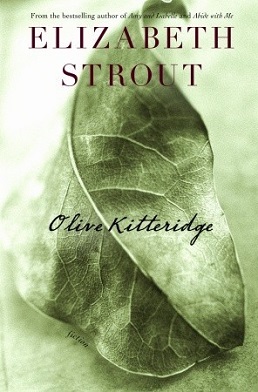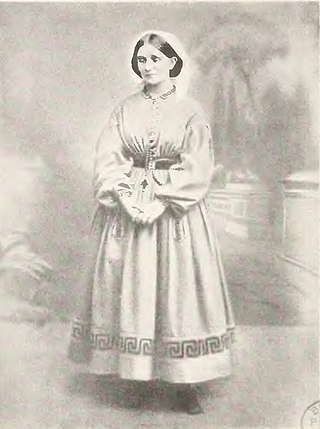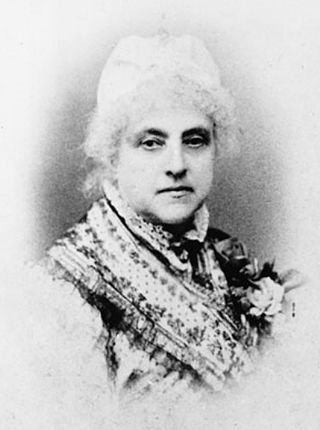
Dorothea Lynde Dix was an American advocate on behalf of the indigent mentally ill who, through a vigorous and sustained program of lobbying state legislatures and the United States Congress, created the first generation of American mental asylums. During the Civil War, she served as a Superintendent of Army Nurses.

Mary Ashton Livermore was an American journalist, abolitionist, and advocate of women's rights. Her printed volumes included: Thirty Years Too Late, first published in 1847 as a prize temperance tale, and republished in 1878; Pen Pictures; or, Sketches from Domestic Life; What Shall We Do with Our Daughters? Superfluous Women, and Other Lectures; and My Story of the War. A Woman's Narrative of Four Years' Personal Experience as Nurse in the Union Army, and in Relief Work at Home, in Hospitals, Camps and at the Front during the War of the Rebellion. She wrote a sketch of the sculptor Anne Whitney for Women of the Day and delivered the historical address for the Centennial Celebration of the First Settlement of the Northwestern States in Marietta, Ohio on July 15, 1788.

The Boston Brahmins or Boston elite are members of Boston's traditional upper class. They are often associated with a cultivated New England or Mid-Atlantic dialect and accent, Harvard University, Anglicanism, and traditional British American customs and clothing. Descendants of the earliest English colonists are typically considered to be the most representative of the Boston Brahmins. They are considered White Anglo-Saxon Protestants (WASPs).

Rebecca Lee Crumpler, born Rebecca Davis,, was an American physician, nurse and author. After studying at the New England Female Medical College, in 1864 she became the first African American woman to become a doctor of medicine in the United States. Crumpler was also one of the first female physician authors in the nineteenth century. In 1883, she published A Book of Medical Discourses. The book has two parts that cover the prevention and cure of infantile bowel complaints, and the life and growth of human beings. Dedicated to nurses and mothers, it focuses on maternal and pediatric medical care and was among the first publications written by an African American on the subject of medicine.

The United States Sanitary Commission (USSC) was a private relief agency created by federal legislation on June 18, 1861, to support sick and wounded soldiers of the United States Army during the American Civil War. It operated across the North, raised an estimated $25 million in Civil War era revenue and in-kind contributions to support the cause, and enlisted thousands of volunteers. The president was Henry Whitney Bellows, and Frederick Law Olmsted acted as executive secretary. It was modeled on the British Sanitary Commission, set up during the Crimean War (1853–1856), and from the British parliamentary report published after the Indian Rebellion of 1857.

Mary Johnson Bailey Lincoln was an influential Boston cooking teacher and cookbook author. She used Mrs. D.A. Lincoln as her professional name during her husband's lifetime and in her published works; after his death, she used Mary J. Lincoln. Considered one of the pioneers of the Domestic Science movement in the United States, she was among the first to address the scientific and nutritional basis of food preparation.

Mary O'Connell, SC was an Irish immigrant to the United States, who became a Catholic religious sister. A Sister of Charity of Cincinnati, she served with distinction as a nurse on the front lines of the American Civil War. Her work with the wounded and in health care in general caused her to be known as "the angel of the battlefield" and "the Florence Nightingale of America." Her portrait hangs in the Smithsonian Institution in Washington, DC.

Anne Whitney was an American sculptor and poet. She made full-length and bust sculptures of prominent political and historical figures, and her works are in major museums in the United States. She received prestigious commissions for monuments. Two statues of Samuel Adams were made by Whitney and are located in Washington, D.C.'s National Statuary Hall Collection and in front of Faneuil Hall in Boston. She also created two monuments to Leif Erikson.

Linda Richards was the first professionally trained American nurse. She established nursing training programs in the United States and Japan, and created the first system for keeping individual medical records for hospitalized patients.
This timeline of the Salem witch trials is a quick overview of the events.
Mary Todd "Mamie" Lincoln Isham was a granddaughter of Abraham Lincoln, the first daughter of Robert Todd Lincoln and the mother of Lincoln Isham.
Virgil Horace Barber was an American Jesuit.
William Seton III was an American author, a novelist and popular science writer. He was from one of America's most distinguished Roman Catholic families. His paternal grandmother was Elizabeth Ann Bayley Seton, the first American citizen to be canonized by the Roman Catholic Church.

Olive Kitteridge is a 2008 novel or short story cycle by American author Elizabeth Strout. Set in Maine in the fictional coastal town of Crosby, it comprises 13 stories that are interrelated but narratively discontinuous and non-chronological. Olive Kitteridge is a main character in some stories and has a lesser or cameo role in others. Six of the stories had been published in periodicals between 1992 and 2007.

Helen L. Gilson was born in Chelsea, Massachusetts. She was a nurse during the Civil War. Also known as Helen L. Gilson Osgood.

Alice Mary Longfellow was a philanthropist, preservationist, and the eldest surviving daughter of the American poet Henry Wadsworth Longfellow. She is best known as "grave Alice" from her father's poem "The Children's Hour".
Daniel Sargent Jr. was a successful American merchant and politician in Boston, Massachusetts.

Sarah Fisher Ames (1817–1901) was an American sculptor, best known for a bust of Abraham Lincoln that she produced in 1866.

Cora Stuart Wheeler was a 19th-century American poet and author. She was one of the most successful short-story writers of the day. It was during the civil war, as a girl in her father's committee-room at the Capitol, during President Lincoln's time, that ideas were formed which developed into her verse of later years. Wheeler, a well-known literary worker and journalist in her day, wrote verse, bits of humor, biographies, and racy, thrilling stories. She gave instructive, entertaining lectures, through which ran good-natured wit and purpose.

Abby Howland Woolsey was an American social worker and nursing educator.















